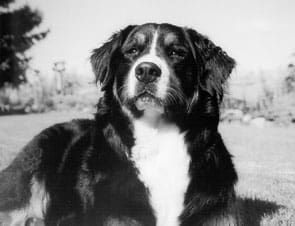In September 1998, our female Bernese Mountain Dog, Annie, became lame with painfully swollen and inflamed joints that were noticeably warm to the touch. She was just over four years old at the time. The sudden initial onset of symptoms occurred about three weeks after her annual vaccinations and a three-year rabies vaccine.
We took her to the vet, of course, who conducted tests and more tests. A thorough blood work-up showed unusual and elevated antibody levels. All tests for Lyme disease, lupus, and rheumatoid arthritis were negative. A complete set of radiographs revealed an amount of arthritis in both elbows that was alarming for a dog Annie’s age, and her right knee was inflamed and full of fluid. Her right carpal joint was also visibly swollen and extremely painful when touched. She licked it incessantly.
After consultations with specialists, we received a diagnosis of nonspecific genetically-based or autoimmune polyarthritis (inflammation occuring simultaneously in multiple joints) as well as confirmed autoimmune thyroiditis (inflammation of the thyroid gland).
Within a month, Annie was limping terribly from the right shoulder and was unable to use her hind legs to jump at all. One night in early October, we realized that Annie could no longer hop onto our bed, but rather just laid beside it and pawed at the dust ruffle. We had to lift her onto beds, sofas, and the car; only a few weeks earlier, these situations were effortlessly negotiated. Now, Annie was unable to hop down to the floor, either; she would try to drag herself off of the furniture with her front legs if we didn’t assist.
Hitting rock bottom
Per our veterinarian’s recommendation, we administered two 75 mg. tablets of Rimadyl each day to ease the pain and control the swelling, but after some initial relief its effectiveness decreased and Annie’s limping and inflammation steadily grew worse. She became depressed and dispirited, and her body was soft and “squishy” from apparent fluid accumulation and lack of muscle tone.
In December, our veterinarian began administering weekly acupuncture treatments, and this did seem to provide temporary pain relief for Annie. However, it didn’t afford a long-term improvement in Annie’s health. After five months of conventional therapy, Annie’s vitality continued to slowly decline. We feared that if she continued on this course we may eventually have to make the difficult decision to end her suffering. Our veterinarian wisely considered it too risky at that time to prescribe steroidal treatments given Annie’s weakened immune system.
Taking a holistic tack
In late January, we located H. Jonathan Wright, a veterinarian in Spokane, Washington, who uses a specialized version of homeopathic medicine called sequential homeopathic treatment (see sidebar, next page). He also specializes in autoimmune disorders.
Dr. Wright took a very proactive, multi-pronged approach to Annie’s care. He immediately made some adjustments to Annie’s diet. We were already feeding Flint River Ranch, which he highly recommended, but he modified it by adding one of Dr. Richard Pitcairn’s all-natural raw diets for half of her daily rations (Pitcairn is the author of Natural Health for Dogs and Cats, one of the earliest books on the subject). Dr. Wright also recommended several supplements to give her body the strength to begin the healing process: antioxidants (grape seed extract) plus omega-3 fish oil capsules, Ester C, Glycoflex, and MSM in initially high dosages.
In order to keep her pain at a minimum, we also temporarily continued Annie’s doses of Rimadyl in conjunction with the new plan, just until we could get the inflammation under control. Annie had also been receiving two 0.4 mg tablets of Soloxine per day since October to elevate her T4 level to within normal range. Dr. Wright added two thytrophin tablets to her daily thyroid replacement therapy. Thytrophin is a natural bovine thyroid PMG extract with no thyroxine It acts as an antibody “decoy,” thus sparing the thyroid gland the autoantibody assault that was compromising her thyroid hormone production.
Homeopathic analysis
At Dr. Wright’s request, I prepared a detailed history of Annie’s medical treatments and conditions for his review and analysis.
The detailed timeline revealed a life-long reaction to her annual vaccines. While Annie had been, by all appearances, a healthy, normally robust and active dog with a beautiful shiny coat, she also suffered from several mysterious maladies throughout her lifetime that were inconsistent with her otherwise vital nature. She suffered from chronic conjunctivitis which had been attributed to undetermined allergies, miscellaneous annual infections, a ravenous eating disorder and subsequent weight problem, and a small lump close to a vaccine site which had to be surgically excised due to the suspicious nature of the tissue cells.
Eventually, Dr. Wright concluded that Annie had perhaps been suffering from lesser but more chronic manifestations of the very diseases that she had been vaccinated against, such as distemper.
After Dr. Wright analyzed Annie’s medical and personality profile, he administered a dose of the homeopathic remedy Thuja to help detoxify the negative effects of the vaccinations. Thuja is not administered in all cases of vaccinosis, but it was the appropriate remedy for Annie’s profile.
Within three days of treatment she became feverish to the touch, especially on the top of her head. After a week she experienced intensely acute arthritic symptoms with increased lameness and distressed panting that lasted about 3-4 days. Although this was a painful time for her, it was the reaction we were told to expect. These symptoms signaled that the healing process was beginning to take place; we had opened a pathway for the body’s natural healing response to begin. After two such episodes the inflammation subsided almost entirely and she started to improve dramatically within two weeks. We began replacing the Rimadyl with homeopathic remedies such as Aconitum for relief of her acute symptoms.
Better than ever?
One of the tell-tale symptoms of Annie’s illness was a chronic inflammation of the eyes, and they became even more inflamed when her joints seemed to be causing her pain. But following the first homeopathic treatment, for the first time in her life, Annie’s eyes were clear. As the swelling in her joints eased, her spirits elevated, and she soon began exhibiting a normal energy level. Within one month, her overall body tone tightened up. While it appeared at the time that she had lost a good deal of weight, in truth her weight remained stable. The inflammation that had invaded her body tissues appeared to have been arrested and she was no longer “squishy.”
Although Annie had vastly improved within a month, Dr. Wright and I agreed it would be beneficial to continue an aggressive sequential homeopathic therapy for Annie to rid her body of any residual toxins and neutralize the lingering effects of previous traumas, such as earlier vaccines, harmful effects of radiographs and surgical procedures. He began administering the homeopathic remedy Sulphur, which was a remedy appropriate to her specific constitutional profile. She has, to date, received specifically timed and formulated single- and multiple-dose homeopathic remedies as needed.
Additionally, we have been able to steadily reduce her thyroid replacement therapy as her overall condition improved. Her latest T4 level, which had ultimately elevated to an above normal rate, has now stabilized to almost within normal range on 0.2 mg of Soloxine daily compared to 0.8 mg, before the homeopathic treatment. It is our hope that as time goes on, we will have successfully corrected the imbalances that precipitated the hypothyroidism and she will no longer be dependent on synthetic hormone replacement.
Both of Annie’s veterinarians agree that her immune system cannot withstand the stress caused by annual vaccinations, and therefore we do not plan to vaccinate her again. To comply with state regulations requiring rabies vaccination, we will run a titer test when necessary. Hopefully, her level of immunity will be sufficient, and our local veterinary college will issue a certificate of adequate immunity.
After six months of sequential therapy with homeopathic remedies, Annie has had no recurrence of joint pain or inflammation, and has been normally active for the past five months. Each night she enjoys a free run in the fields around our home, pain-free. The same dog who could not tolerate mild joint manipulation last winter shows no pain response at all when examined these days. We still have work to do on her treatment schedule, and we fully anticipate the possibility of a brief reappearance of some earlier symptoms as we make the journey backward through her timeline. Still, her progress to this date, almost the one-year anniversary of her initial crisis, has been nothing short of amazing.
Also With This Article
Click here to view “Homeopathy: An Alternative Theory of Medicine”
Click here to view “Using Homeopathic Remedies to Help Your Dog”
-By Catherine Schulhauser
The author wishes to acknowledge and publicly thank Dr. Veronika Kiklevich and Dr. Jonathan Wright for their care, compassion and dedication.







thats fantastic to hear. My bernese boy had a very similar experience, starting at 3 months old, shortly after his first vaccinations, after nearly a year and 4,000$ and still no answers from our vet, we took him to a holistic vet/doctor and he had him so much better within weeks. This is a very real thing, and we also will never vaccinate him again, titers only from here forth.